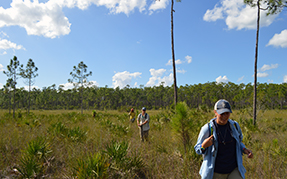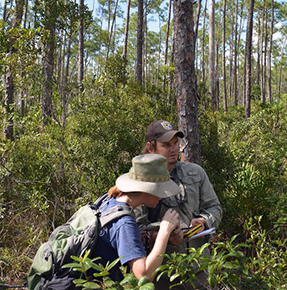Everglades National Park fire management staff partnered with the U.S. Fish and Wildlife Service and Student Conservation Association to evaluate new methods for locating pineland croton in the pine rocklands of Everglades National Park. Shade-intolerant pineland croton is the host plant for two federally endangered butterflies. Without fire, pineland croton may be outcompeted by hardwood succession, resulting in habitat conversion from pine rockland to hardwood hammock within a few decades.


Everglades National Park fire management staff spent three days in the field partnering with U.S. Fish and Wildlife Service and the Student Conservation Association to evaluate new methodologies used to locate pineland croton (Croton linearis) in the pine rocklands of Everglades National Park.
Pineland croton is the host plant for two federally endangered butterflies, the Bartram’s hairstreak (Strymon acis bartrami) and the Florida leafwing (Anaea troglodyte floridalis). Without fire, pineland croton, a shade-intolerant plant, may be outcompeted by hardwood succession, resulting in habitat conversion from pine rockland to hardwood hammock within a few decades.

Currently, the Bartram’s hairstreak population encompasses both Everglades National Park and the National Key Deer Refuge in Big Pine, Florida; however, the Florida leafwing butterfly is found only within Everglades National Park. Biologists and researchers at the National Key Deer Refuge were the first to develop population estimates for the Bartram’s hairstreak and were able to delineate important habitat patches used to aid in management efforts to support the Bartram’s hairstreak population.

Using an integrated approach and similar techniques for monitoring host plants and their associated butterflies will provide land managers from both bureaus a cohesive strategy for monitoring local butterfly populations. New techniques for locating and monitoring the pineland croton will help fire managers effectively plan landscape-level prescribed fire operations with an increased awareness of the relationships among fire, pineland croton, and the endangered butterflies.
Read more information on pine rocklands.
Contact: Chief of Fire and Aviation
Phone: (305) 242-7853
Last updated: December 14, 2017
